
With the calling of the 2019 Australian Federal Election for May 18, 2019 and Facebook’s seemingly ‘meh’ approach to controlling of advertising in Australia around issues of national importance, I thought I’d scope out what a Facebook advertiser could do to help or make life difficult for politicians and their respective parties.
I write this out of frustration with Facebook’s public position to elections in Australia. Facebook will now use their international foreign influence tools, but despite our Prime Minister calling the election, we still don’t have to be certified in order to run ads about issues of national importance.
My hope is to demonstrate how gobsmackingly easy it is in Australia to run hyper targeted ads, using Facebook’s publicly available tools, to push a political stance to influence a neighbourhood, a postcode, a key electorate.
The Electoral Act
Before we begin, it is important to note that if paid political ads like this did run, without the approval of the Australian Electoral Commission, then the advertiser would be in contravention of the Commonwealth Electoral Act 1918 (the Electoral Act).
According to the AEC, they will write to the advertiser to request that the ads be taken down until they are authorised. If the advertising persists, the AEC will seek to impose a civil penalty through the courts.
You can read the AEC Requirements here.
I seek to highlight the disconnect in the requirement of the Electoral Act and the ability to sponsor a political message on Facebook to electors. There may be communication between the AEC and Facebook, IF the AEC finds and reports an ad to Facebook. There is however, little on Facebook’s side to prevent the ads from being created and run in the first place, despite the availability of the processes in other countries.
How to influence Australian Voters on Facebook for $20 a day
Assumptions
- The advertiser lives in the Victorian electorate of Goldstein, currently held by Tim Wilson.
- The advertiser has intent to push the incumbent out, or encourage a swing against, to remove the seat’s safe status, for whatever reason.
- The advertiser has played the long game, and has constructed or participated in communities (Facebook Groups) and has multiple pages at their disposal (to make active, anticipating some may be taken down) that they have been building.
- The advertiser has had a primary Facebook page that they have been using for some time, posting various things about the community, such as “What’s On”, local topics of interest, crime, politicians, parks, incidents, council news etc. This page has gained audience and trust.
- The advertiser takes a “Black Hat” (unethical, game the system) approach to Facebook advertising.
- The advertiser has not sought approval to advertise from the AEC and is operating on a “do now, apologise later” premise, under the assumption that it will take days/weeks for the ad to be reported to the AEC and for the AEC to communicate the take down request with the advertiser.
- The advertiser also goes into this assuming that they will not have the ads flagged initially by Facebook’s AI for political advertising. It will most likely take a human review.
The advertiser has constructed a page called “Living Bayside” and used local recognisable imagery (from Google images) so the page is more easily picked up by the eye by a local user in the news feed.

Now, onto the advertising. We’re assuming the community has been built, but we can also advertise from a newly created page. It does however help your ability to run ads en masse if your page and ad account has been around for a while.
Does this page, being from Australia, have to be approved by Facebook to advertise about issues of national importance?
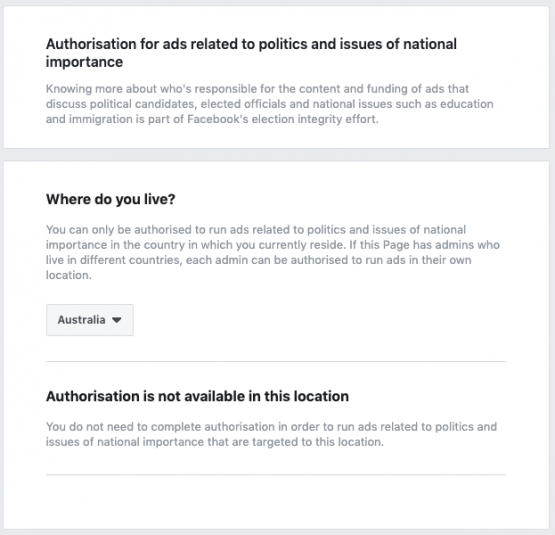
Despite being weeks out from the election, no it does not.
Going into Facebook Business Manager, we go into our ad account and click “Create ad”. This presents the options below.

For this purpose we want to hit everyone on Facebook, within an area, multiple times a day. Therefore we will be choosing the “Reach” objective.
Now, what’s a hot topic for the nation at the moment? Energy! Power prices, Coal v renewables, Power outages. It’s all happening.
The advertiser has noticed that the Member for Brighton in the Victorian Parliament recently posted about a power outage that affected a neighbourhood.

Targeting
James Newbury MP, has kindly provided a map of the power outage above, so let’s find that arch-shaped neighbourhood in Brighton using Facebook’s mapping tool.
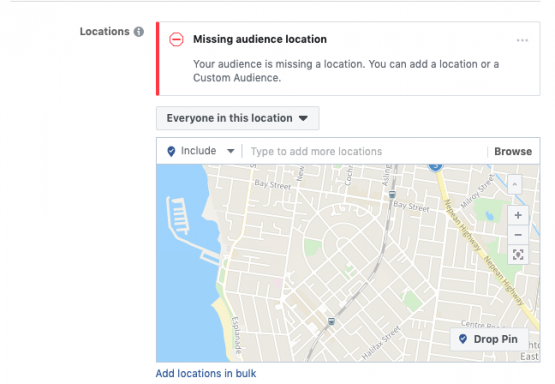
The advertiser goes to the map tool, zooms in and types in “Brighton, Victoria”. From here they can can then search for a nearby street, or even type in an address.
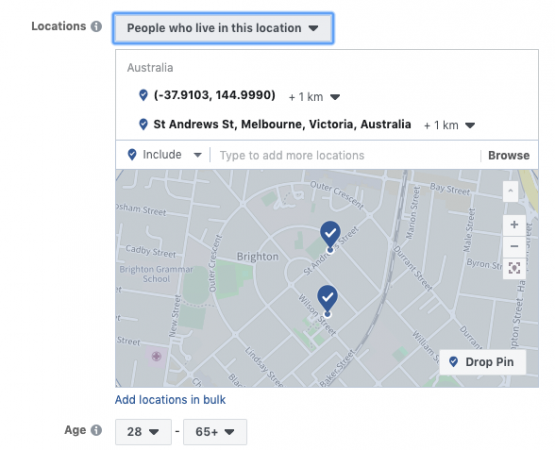
In the above image, they searched for St Andrews Street, Brighton, and then dropped a pin to focus the location.
The advertiser then chose people who live in that location, and changed the age range to those who are more likely to pay electricity bills.
Now, yes, there is a bit of location overshoot compared to the power outage map, but 1 km is as low as Facebook goes.
The advertiser could also target the whole electorate, by postcode. A quick search on Google gave them a few official government sites with postcode by electorate information.
Facebook provides the ability to load postcodes and other areas into the map, in bulk.
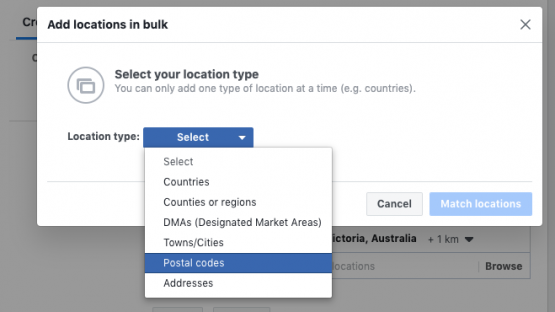

The advertiser then enters the Goldstein postcodes in the specified format, and Facebook goes and finds the locations. The advertiser double checks the matching.
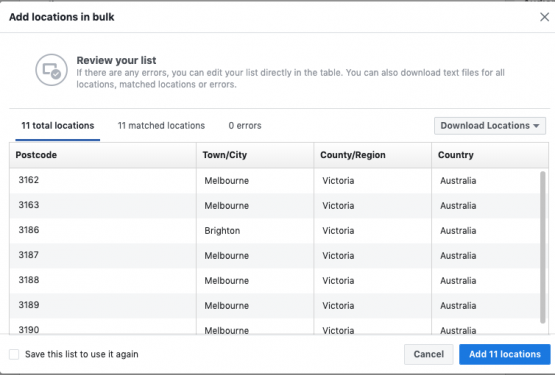
And voila, a nice clean map of the Goldstein electorate according to Facebook’s postcode boundaries.

The advertiser could also enter in interests to narrow the targeting to those who have show interests in posts, pages and websites related to the topic.
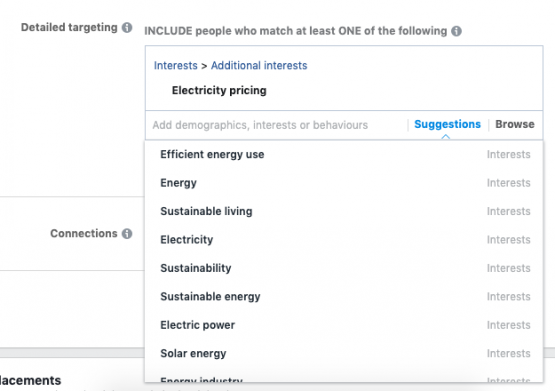
They can then narrow it down even further to get the ideal mix. This works better the bigger audience you have. Facebook does have a cut off when the audience is too small or unobtainable.
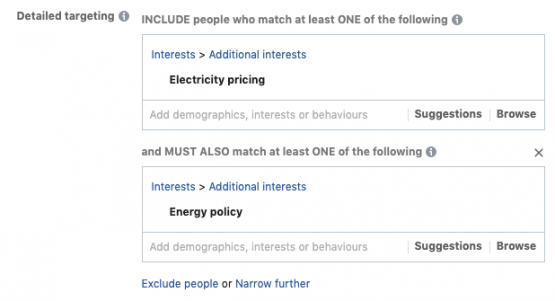
For this exercise though, interest targeting is not going to be used because the advertiser wants to reach as many people as possible a few times a day with their message.
Budget and Audience Size
Next the advertiser is going to run the numbers on how many Facebook users can be reached for the desired price/outcome.
As per this posts title, the budget is $20 per day.
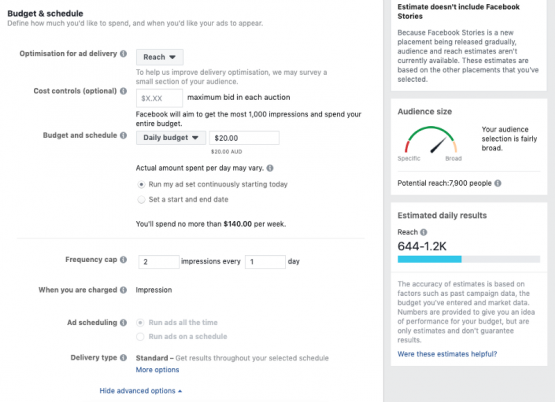
Here we can see that the 1 km radius around the pin that was set above contains potentially 7900 people who live there. Seems high but we’ll roll with it for now.
The campaign has been optimised for reach, they’ve told Facebook they want the ad shown twice a day, every day, to as many people as the ad can reach within that area.
For the $20 a daily budget, that ad will reach 644–1.2k Facebook users a day within that 1 km radius.
Creative
Onto the ads themselves.
The advertiser has access to a lot of stock imagery from Shutterstock, due to a deal between Shutterstock and Facebook. They search for ‘electricity’ and ‘blackout’.

The advertiser even has the option to use the video tool to make the ads more eye-catching in the newsfeed. This makes the image move or zoom closely, like a video.
In this instance, still images were used.
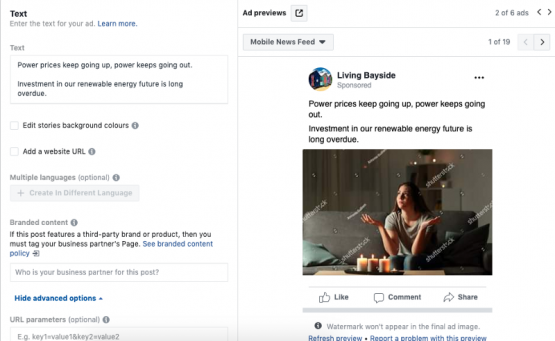
The advertiser selects the images they want, then they enter the text. In this instance, the advertiser is pushing for Facebook users to consider investment in renewables when they vote in May.
Advertisers can enter many combinations of images and text to test which combination works best.

The advertiser then clicks “Submit” and the ads go through Facebook’s review system to be approved.
Interestingly enough, after I disposed of the drafts, I received a question in the ad account screen whether I was running political ads. Facebook could have detected this via the targeting and text in the ad.
![]()
Because the advertiser in this fictional instance is a “black hat” advertiser, they’ll click no to divert the attention off the account until the next warning, or when the ads are reported. If the ads were found to be political by Facebook I’d expect the page and account to be banned, but so would the unethical political advertiser. They’d have pages, business managers, ad accounts and credit cards ready to go.
Unfortunately it seems advertising on Facebook in Australia for political purposes is still a 2016 US election-esque case of “catch me if you can”.
See the original post on Medium here.
What do you think about the ease of political advertising on Facebook in Australia? Write to boss@crikey.com.au with your full name and let us know.







Bravo Myles – an exceptionally well researched article, and very well explained. I guess we’ll know which side of politics were better at mastering this dark art in just over 3 weeks time.
We already know who’s better at this dark art, the “Labor’s gunna steal/tax/ban your ute ” ads are about a fortnight old.
Nice work Myles. It’s specialist quality pieces like this that keep me subscribing to Crikey. More please.
Now THAT is what I call journalism – well bloody done!
Scary as.
Good work MH.
Just as disturbing as I expected.
So this is Freedom for “freedom boy” Wilson ?? Great detective work here.